Here’s how to cook all the pantry items you stocked up on
Get creative with your ingredients.
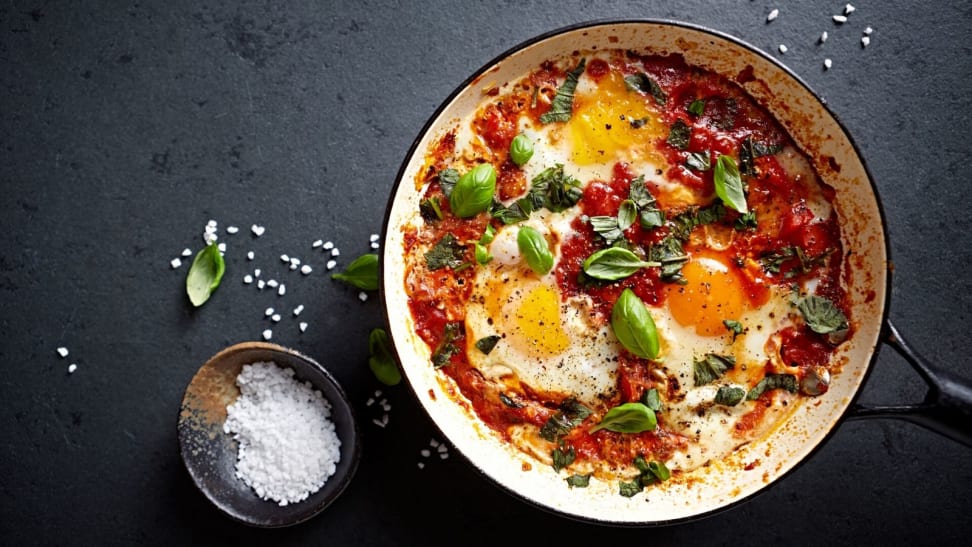 Credit:
Getty / barol16
Credit:
Getty / barol16
Recommendations are independently chosen by Reviewed's editors. Purchases made through the links below may earn us and our publishing partners a commission. Prices were accurate at the time this article was published but may change over time.
If you’re one of the millions of people working from home and living in isolation as a result of the COVID-19 pandemic, there’s a good chance you’re panicking about food. When will grocery stores restock? How long will the supplies you currently have last? Can you afford to buy a month’s worth of groceries all at once? It's an uncertain time, and feeding yourself and your family might feel daunting.
But if you’re stuck at home with piles of rice, pasta, frozen vegetables, beans, and other pantry staples and have no idea what to cook with them, we’re here to help. With the right recipes and a bit of creativity, you can turn just these few items into weeks and weeks of flavorful, satisfying, and nutritious meals. Here are my top tips and favorite recipes to get you through quarantine:
1. Beans are your best friend
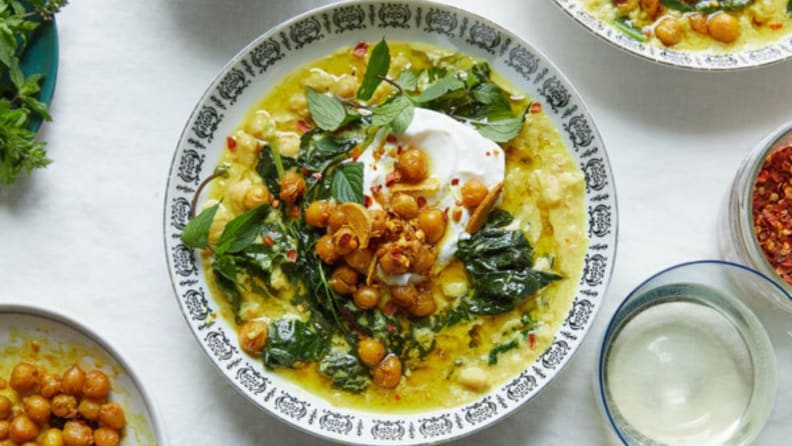
Alison Roman's chickpea stew is proof of the power of legumes.
I’ve heard so many people say that they don’t like beans, and to that I say: You just have to learn how to cook with them. These legumes are a cornerstone of vegetarian diets for a reason—they’re super nutritious, versatile, and can be incorporated into many hot and cold dishes. Oh, and they won’t spoil, unlike meat and seafood.
Dried beans that you cook yourself are always going to end up tasting better than canned beans, but either will do, especially if you’re cooking with them for the first time. If you’re just heading to the store to stock up, I recommend getting both dried and canned beans of many varieties (like black, cannellini, red, and pinto) to have in storage.
Already stocked up? Start simple with this Cheesy White Bean-Tomato Bake that I already make about once a week. All you need is garlic, tomato paste, cannellini beans, olive oil, and a bit of cheese. Pair with some crusty bread and a salad (if you have fresh greens) and you’ve got yourself a complete dinner.
Have some frozen shrimp on hand? This Lemony Shrimp and Bean Stew is another easy white bean recipe that I love making year round, but particularly when I’m in need of comfort food. You can easily swap out the shrimp for other fish, or ditch the fish and toss with pasta for a larger meal. We also love this recipe for Instant Pot Sausage and White Beans, which feeds a crowd and can easily be frozen and saved for later.
When you’re considering your bean options, don’t forget about other legumes like chickpeas and lentils, which are both diverse categories in and of themselves. This Spiced Chickpea Stew With Coconut and Turmeric smells as delicious as it tastes, and can easily be made with frozen greens in place of fresh ones. You can also fold chickpeas into your pasta, or blend them up into hummus. Lentils can be enjoyed as a side dish, the base for a salad, or turned into a soup like this Red Lentil Soup With Lemon.
2. Get creative with eggs

Eggs can be turned into a Japanese tamagoyaki omelette.
If you’re someone who eats eggs, you probably don’t have to be reminded how great they are. They can be boiled, fried, poached, scrambled, steamed, and turned into a wide variety of dishes that aren’t just for breakfast. But on your tenth day of putting hard boiled eggs in your work-from-home lunch salad, you might start to wonder what other possibilities exist.
You can try something new with a tamagoyaki, or rolled Japanese omelette. Or maybe you’re interested in something less technically challenging, like a classic frittata. Frittatas are excellent stuck-at-home food because they’re straightforward, totally customizable, and can be served at any meal. Perfecting a frittata is a worthwhile pursuit, trust me.
One of my favorite ways to cook an egg is in this Indian-Spiced Tomato and Egg Casserole, which is very similar to shakshuka but adds a layer of potato. Hearty, spicy, and filling, egg casseroles like this are a great way to use up all the eggs and canned tomatoes you stocked up on.
3. Pasta goes with more than tomato sauce
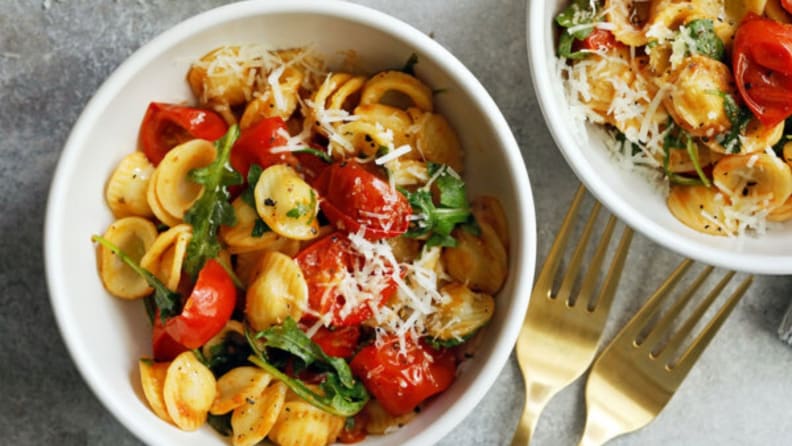
Have a lot of pasta on hand? Mix up your routine with fresh recipes.
The most obvious pantry item, aside from rice, is probably pasta. Pasta is what we turn to in hard times: It’s filling, crowd-pleasing, cheap, and can be made any way you like it. But if you’re already getting sick of spaghetti and your standard pasta recipes, you might want to pivot to something new.
One pasta recipe I’ve already made twice during this period of social distancing? Orecchiette With Cherry Tomatoes and Arugula. It’s crazy simple, fresh-testing, and makes great leftovers. I usually toss in some frozen shrimp for protein, too.
When I’m totally broke, I like to pivot between two pasta recipes: Midnight Pasta With Garlic, Anchovy, Capers and Red Pepper for dinner, and tuna pasta for lunch. The “midnight pasta” is about as easy as it gets, with standard pantry items giving it the bulk of its flavor. And tuna pasta is exactly what it sounds like—I mix a short, textured pasta like orecchiette with canned tuna fish, mayo, and a ton of parsley, salt and pepper to make a simple cold pasta salad. You might be noticing that both these meals also use tinned fish, another pantry staple.
Want to do something with all the ramen you have lying around? Try jjapaguri, or “ram-don,” the Korean-Chinese noodle dish (popularized in America by the Oscar-winning "Parasite") that turns two types of ramen and some pieces of steak into a delicious meal.
My friend recently invested in a pasta machine so they can make fresh pasta right at home. If you're looking for a project, this is also a great option.
4. Invest your time in stews and curries
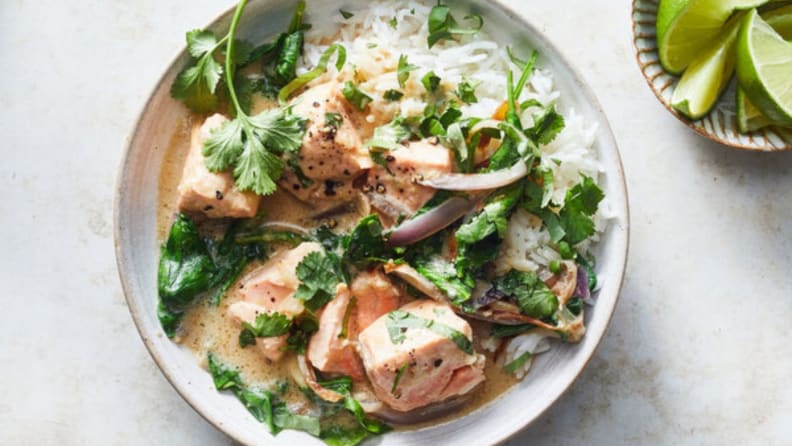
Curries and stews are the perfect stuck-at-home food.
Stews and curries can provide warmth and comfort on cold winter days, but that doesn’t mean you have to give them up just because it’s spring. These dishes build flavor over time and are typically very affordable, making them perfect projects for when you have a lot of time but not a lot of money (or access to fresh produce).
Beyond the few stews I already mentioned, I’m a fan of this classic Best Ever Beef Stew, which is not vegetarian friendly but absolutely delicious for those who eat meat. Stews like these can be made in a slow cooker, pressure cooker, or on the stovetop in a Dutch oven, depending on what you have.
Curries pack even more flavor and, once you get the hang of working with aromatics and spices, you can truly customize your own. When I’ve got nothing but garlic, onions, ginger, coconut milk, and rice in the house, I always like to experiment with curries. One recipe I keep coming back to? This Coconut-Miso Salmon Curry. The miso gives it an excellent depth of flavor, while the lime and herbs keep it bright and refreshing. This Coconut-Lime Shrimp provides similar flavors with fewer ingredients.
If you’re working with an Instant Pot, you might also be interested in this Pressure Cooker Coconut Curry Chicken.
5. Try new baking projects
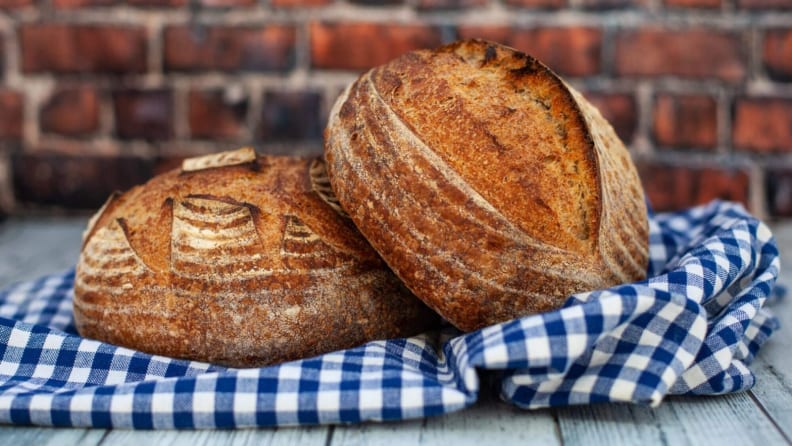
If you've got nothing but time, consider learning to bake bread.
You may know someone who has recently gotten really, really into baking bread. I have at least three friends who have let bread become their primary hobby. Why? It’s time-consuming, pretty simple, and very fulfilling—and you get bread out of it. My housemate recommends this complete guide to baking sourdough bread, but beginners may also be interested in this simple, popular No-Knead Bread.
If bread isn’t your style, there are plenty of other baking projects worthy of your time. Another friend recently made a load of these Lemon Bars With Olive Oil and Sea Salt that instantly brightened my day. If you want something even simpler, I recommend this Lemon Poppy Seed Pound Cake that I baked a few weekends back.
If you spend any time on Instagram or Bon Appétit, you may have already heard of Molly Baz’s super moist Earl Grey Yogurt Cake, which I counted on no fewer than four Instagram stories yesterday. It’s so simple, anyone can make it. Most of these recipes use basic pantry items like flour, sugar, eggs, tea, butter, and olive oil, so you can bake with what you have and impress your friends and family.
Not sure how to store all your extra pantry items? We made a guide for that, too. Once you have the supplies you need and a few solid recipes under your belt, you’ll be a pantry cooking pro in no time.





